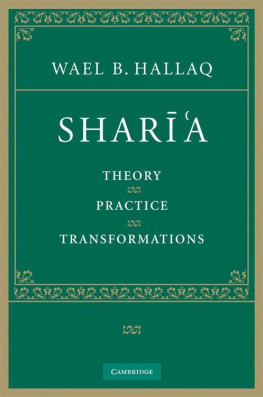Wael B. Hallaq - An Introduction to Islamic Law
Here you can read online Wael B. Hallaq - An Introduction to Islamic Law full text of the book (entire story) in english for free. Download pdf and epub, get meaning, cover and reviews about this ebook. year: 2010, publisher: Cambridge University Press, genre: Religion. Description of the work, (preface) as well as reviews are available. Best literature library LitArk.com created for fans of good reading and offers a wide selection of genres:
Romance novel
Science fiction
Adventure
Detective
Science
History
Home and family
Prose
Art
Politics
Computer
Non-fiction
Religion
Business
Children
Humor
Choose a favorite category and find really read worthwhile books. Enjoy immersion in the world of imagination, feel the emotions of the characters or learn something new for yourself, make an fascinating discovery.
- Book:An Introduction to Islamic Law
- Author:
- Publisher:Cambridge University Press
- Genre:
- Year:2010
- Rating:5 / 5
- Favourites:Add to favourites
- Your mark:
- 100
- 1
- 2
- 3
- 4
- 5
An Introduction to Islamic Law: summary, description and annotation
We offer to read an annotation, description, summary or preface (depends on what the author of the book "An Introduction to Islamic Law" wrote himself). If you haven't found the necessary information about the book — write in the comments, we will try to find it.
An Introduction to Islamic Law — read online for free the complete book (whole text) full work
Below is the text of the book, divided by pages. System saving the place of the last page read, allows you to conveniently read the book "An Introduction to Islamic Law" online for free, without having to search again every time where you left off. Put a bookmark, and you can go to the page where you finished reading at any time.
Font size:
Interval:
Bookmark:

 a, has in particular become an ugly term, as often associated with politics as with the chopping off of hands and the stoning of women. An endless array of popular books have distorted Shari
a, has in particular become an ugly term, as often associated with politics as with the chopping off of hands and the stoning of women. An endless array of popular books have distorted Shari a beyond recognition, confusing its principles and practices in the past with its modern, highly politicized, reincarnations. Considering Shari
a beyond recognition, confusing its principles and practices in the past with its modern, highly politicized, reincarnations. Considering Shari as historical role as the lifeblood of Islam, we have little hope indeed given these distortions of understanding the history and psychology of as much as one-fifth of the population of the world in which we live.
as historical role as the lifeblood of Islam, we have little hope indeed given these distortions of understanding the history and psychology of as much as one-fifth of the population of the world in which we live. a provokes distaste and even fear on our part. What brought this about? Was the Shari
a provokes distaste and even fear on our part. What brought this about? Was the Shari a as harsh and oppressive as it is now depicted in the media? What were its doctrines and practices in history? How did it function within society and the moral community? Under what conditions did it coexist with the body-politic? How was it colonized and largely dismantled? And, finally, how were its remnants transformed into an oppressive regime, wielded above all by the relatively new nation-state (perhaps the most important factor in Shari
a as harsh and oppressive as it is now depicted in the media? What were its doctrines and practices in history? How did it function within society and the moral community? Under what conditions did it coexist with the body-politic? How was it colonized and largely dismantled? And, finally, how were its remnants transformed into an oppressive regime, wielded above all by the relatively new nation-state (perhaps the most important factor in Shari as modern transformation)?
as modern transformation)? a by the modern state was made possible through dynastic control of traditional legal education.
a by the modern state was made possible through dynastic control of traditional legal education. a not only for the purposes of acquiring political legitimacy by the ruler but also for achieving just rule as the ultimate realization of Gods will. Governance according to the Circle of Justice represented one of the highest forms of the rule of law, where the state itself was subject to a law not of its own making (unthinkable in our modern state system).
a not only for the purposes of acquiring political legitimacy by the ruler but also for achieving just rule as the ultimate realization of Gods will. Governance according to the Circle of Justice represented one of the highest forms of the rule of law, where the state itself was subject to a law not of its own making (unthinkable in our modern state system).
Font size:
Interval:
Bookmark:
Similar books «An Introduction to Islamic Law»
Look at similar books to An Introduction to Islamic Law. We have selected literature similar in name and meaning in the hope of providing readers with more options to find new, interesting, not yet read works.
Discussion, reviews of the book An Introduction to Islamic Law and just readers' own opinions. Leave your comments, write what you think about the work, its meaning or the main characters. Specify what exactly you liked and what you didn't like, and why you think so.










